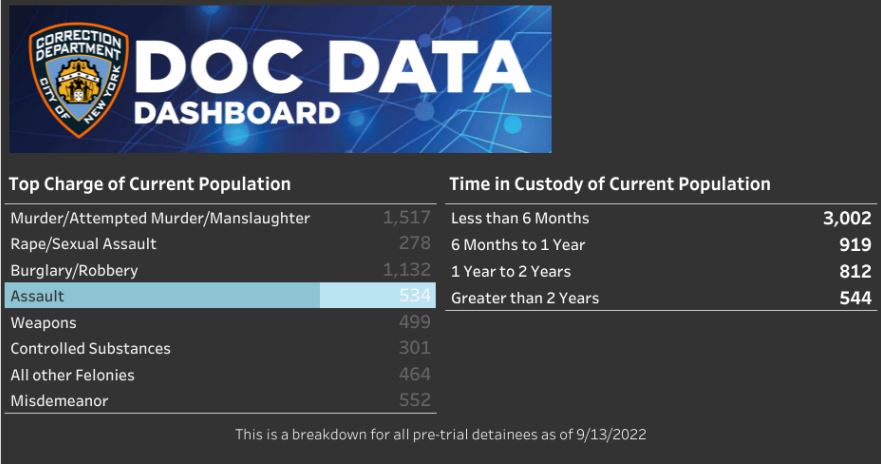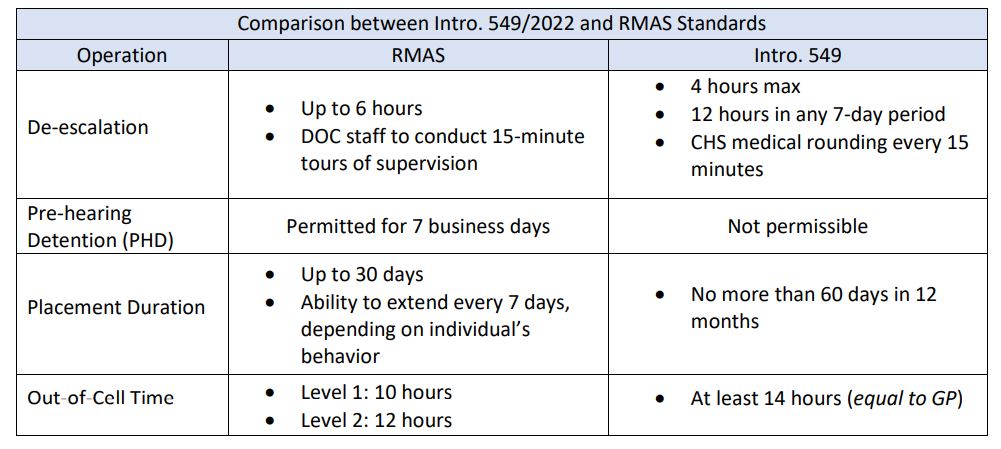
 Correction311
Correction311 Search all NYC.gov websites
Search all NYC.gov websites
News
Testimony before the
New York City Council
Committee on Criminal Justice
Chair Carlina Rivera
By
Louis A. Molina, Commissioner
NYC Department of Correction
September 28, 2022
Good morning, Chair Rivera and members of the Committee on Criminal Justice. I am
Louis Molina, Commissioner of the Department of Correction (“Department”). I am joined today
by the Department’s General Counsel Paul Shechtman and a renowned correctional expert, Dr.
James Austin, who was recommended to the Department by the Federal Monitor in the Nunez case to develop additional measures to protect incarcerated individuals and our correction officers from violence. I want to thank you for giving me the opportunity to testify today on Introduction Number 549, which is described as a bill “to ban solitary confinement in City jails.” This legislation is extraordinarily important to the Department as we work to implement the Nunez Action Plan and
unravel the legacy of decades of mismanagement that have led to an environment of violence and
fear within our jails. As I hope to explain, if enacted, Intro. 549 would have grave consequences.
It would make the job of running a humane and safe jail system far more difficult.
Humane and Safe Jails
Let me begin by saying that we fundamentally agree on a very important point. Our jails
should be humane, and solitary confinement is inhumane. For too long, it was accepted
correctional practice to lock individuals in small cells for 23 hours a day, for months or years at a
time, without any contact with other human beings. That practice was wrong. Let me be clear: I
strongly oppose solitary confinement. Not only is it inhumane, it does not make our jails safer. I
will not permit anything like it on my watch.
I think we can also fundamentally agree that our jails must be safe. Humane treatment and
safety are not two separate goals or parallel tracks; they are inextricably linked. When we talk
about humane jails, we are talking about safe jails; a jail cannot be humane if it is not safe.
Likewise, providing people with an environment that is safe, that is not overrun with fear and
violence, that is stable and ordered, is humane. That principle has guided our work over the course
of the past nine months, and it will continue to guide our work in the months to come.
Proposed Legislation
If this bill solely banned solitary confinement, it would have my total, unwavering support.
But that is not what this bill is about. It does much, much more. The consequences of this bill, if
enacted, are profound and benefit neither people in custody, nor staff, nor the public at large. That
is what I want to address this morning.
I’d like to tell you my understanding of the bill and its consequences. If I get something
wrong, I hope that you will correct me.
First, the bill seems to allow for some form of “restrictive housing” that is more restrictive
than general population. But I don’t think that it actually does. The bill states that “incarcerated
individuals must have access to at least 14-out-of-cell hours every day except for individuals
placed in confinement for de-escalation…and emergency lock-in.” Individuals housed in general
population in our facilities currently have 14 hours out-of-cell everyday. Thus, under the bill,
individuals in so-called restrictive housing would be out-of-cell for the same length of time as
those in general population.
Second, under the bill, individuals placed in restrictive housing must have “comparable
interaction with other individuals and access to comparable congregate programming and
comparable amenities to those housed outside restrictive housing.” That means they must be
treated no differently from those in general population. Under the bill, the Department would be
prohibited from placing limitations on commissary or other privileges.
If you take both of these points together – that individuals in restrictive housing must have
14 hours out-of-cell and that they must have comparable amenities – then restrictive housing under this bill is not restrictive at all. It is general population. To put it bluntly: Intro. 549 would make it impossible for the Department to impose any sanction or measure of accountability on an
incarcerated individual who has committed a violent act against another incarcerated individual or
against our staff.
It would not be possible to manage a jail under such constraints; no one could work there
or live there safely. Yet the bill goes further.
Third, the bill states that the Department must use “positive incentives” to encourage good
behavior in restrictive housing and may use disciplinary sanctions only as a last resort. If I am right
that restrictive housing under the bill is no different than general population – same time out of
cell, same amenities – then a requirement to provide positive incentives to those in restrictive
housing means restrictive housing areas would actually be better, more desirable places to be
housed in than general population. In essence, the bill would incentivize individuals in our custody
to commit violent acts in order to be placed in a more desirable setting. That makes no sense.
Fourth, the bill would prohibit pre-hearing detention. Pre-hearing detention refers to a
practice in which a perpetrator of a violent act is removed from general population and placed in
restrictive housing immediately following the act, pending the outcome of an adjudication hearing.
This is done for the safety of staff and other people in custody, including the victim of the attack.
Intro. 549 states that the Department cannot place an incarcerated individual in restrictive housing
until a hearing is held and the individual is found guilty of committing a violent offense. Further,
the bill states that the incarcerated individual has a right to counsel at the hearing and to a
reasonable adjournment, which can easily mean delays of seven to 10 days, or more.
Let me tell you in plain language what that means. The Department would have no ability to
meaningfully separate perpetrators of violent acts from the rest of the population prior to a hearing.
Every person working with that individual – uniform staff, non-uniform staff, external providers,
medical providers, mental health providers – and every person housed with that individual would
be forced to share congregate space with them, to share a recreation yard with them, or a visit floor, knowing they had just committed a violent offense – one that they could do again. Our hands
would be tied for 10 days or more.
With bail reform, our facilities house a high concentration of individuals charged with violent
crimes. Here are the statistics:
As the chart shows, roughly 30% of the individuals in our custody are awaiting trial on charges of
murder, attempted murder, or manslaughter. A great many are gang affiliated. They are capable of
extreme acts of violence.
Let me underscore the point with these short videos of recent incidents in our facilities.
1. This incident occurred in RNDC in July 2022
2. This incident occurred in GRVC in August 2021.
3. This incident occurred in MDC (which is now closed) in June 2020.
4. This incident occurred in AMKC in April 2022.
To repeat, as drafted, the bill would not allow the Department to take any action against any
of the individuals until after a hearing with counsel. Until then, they would remain in general
population.
In addition to these videos, I would like to direct you to the photos behind me so you can get
a sense of the violence that our officers in the facilities endure. These officers were seriously
injured by people in custody during the course of their regular duty.
1. Image 1
2. Image 2
3. Image 3
4. Image 4
The perpetrators of such egregious acts must be held accountable – not in solitary confinement
– but in some form of restrictive housing that sends a clear message that their conduct is
unacceptable, and aims to prevent future occurrences.
As you undoubtedly know, in June of 2021, the Board of Correction promulgated a rule
requiring the Department to implement a Risk Management and Accountability System
(“RMAS”). The chart on the screen compares RMAS to the current bill.
Under RMAS, pre-hearing detention was permissible. Under the bill, it would not be
permissible. RMAS out-of-cell time for restrictive housing was 10 to 12 hours. Under the bill, it
would be 14 hours, the same as general population.
In their June 2022 report, the Federal Monitor wrote this about RMAS:
The Monitoring Team’s collective 100 years of experience in correctional
management, expertise in the development of credible programs serving as alternatives to
punitive segregation, and deep knowledge of the Department has led to a consensus that
proceeding with RMAS . . .is not prudent and poses significant safety concerns.
Accordingly, the Monitoring Team does not, at this juncture, approve the . . . the
implementation of RMAS.
If the Federal Monitor concluded that RMAS posed significant safety concerns, it is a
certainty that he would be opposed to this bill as well. As with RMAS, he would find that the bill
puts people in custody and correction officers at greater risk of serious harm. This bill also
undermines the authority of the Federal Court, which has directed that the Department to develop
a new restrictive housing system that adheres to best correctional practices, subject to the
Monitor’s approval.
Conclusion
For the last nine months, my team and I have worked tirelessly to improve conditions in
our jails, and we have seen successes. However, during that time, we have also seen tragedy. There have been sixteen deaths. One death is one too many. Obviously, we still have work ahead of us. Our goal is the same as yours: our jails must be humane. The only way to make them humane is to ensure that they are safe. This bill, if enacted, would make our facilities far less safe for every person that enters to do their jobs, and it would endanger every person in our custody. I urge you not to endorse it.
Thank you for the opportunity to speak today. Dr. Austin has brief testimony, and then we
are available to answer any questions that you may have.




